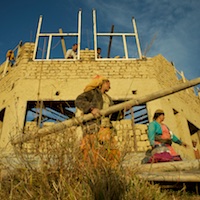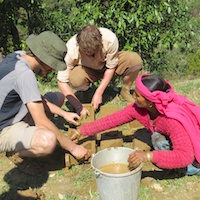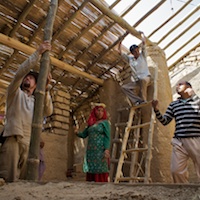 What: Intensive service-learning workshop
What: Intensive service-learning workshop
Topic: Earthen building methods & techniques
Where: Dharmalaya Institute in Bir, HP, India
When: 22-27 June 2015 (must attend from the beginning)
Language: English (with Hindi translation if needed)
Facilitators: Mark Moore, Sidney Rosario, et al.
Description: Week-long, residential service-learning programme at the Dharmalaya Institute providing hands-on training in traditional, eco-friendly earthen building techniques of the Himalayas. Learn by doing, in the real-world context of helping to build a few new structures on the Dharmalaya campus. Activities will depend on the needs on site (and the weather), but are likely to include earthen renders (mud plasters), foundations and plinth, stonework, and possibly other methods and techniques of earthen building.
› What is Vernacular Eco-Architecture? See this page for an introduction.
After introductions, orientation, and general overview of the programme, we will get straight to work doing various hands-on projects around the Dharmalaya campus, including work on several earthen structures that are in various stages of construction. The main focus during this programme will be on plastering and weatherproofing our newest buildings so they will be protected from the rains. The work might include mud plasters, foundation work, stonework, and possibly other techniques. We may do some water flow management as well, in preparation for the coming rainy season.
Workshops and groups sessions may include the following (depending on weather and the needs of the site):
- Hands-on education in traditional earthen building methods of the Himalayas
- Earthen renders (mud plasters)
- Foundation and plinth work
- Other natural building materials and methods (e.g. stone, bamboo, wood, etc.)
- Natural landscaping and water management
What to expect:
- Practical, hands-on training focus (no theory classes in this workshop).
- Opportunities to learn traditional methods by working alongside village artisans.
- You will be working with your hands and body for approximately six hours per day on most days of the programme, so it is recommended to be in reasonably good physical fitness when you arrive, and to bring work clothes.
- Beautiful, rustic, village setting with a simple lifestyle.
For more information see dharmalaya.in/events/2015/3/25/earthen-building-workshop-22-27-jun-2015.html




You must be logged in to post a comment.